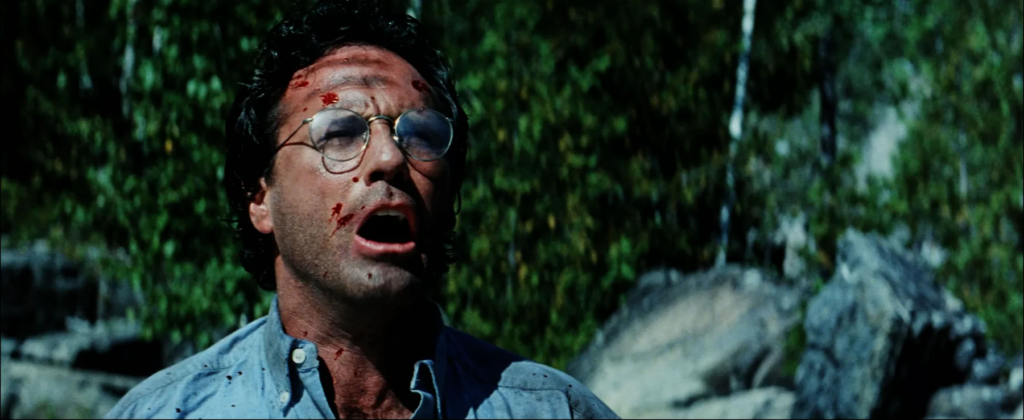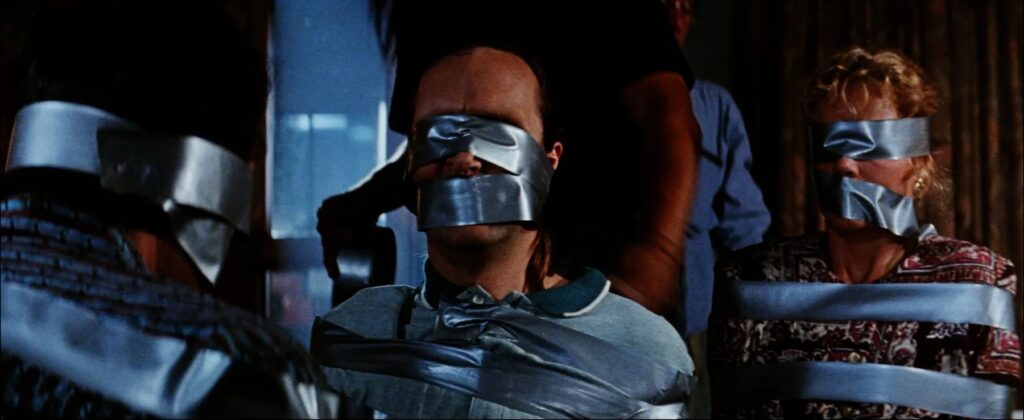| Chris Polley |

A new restoration of Clearcut plays at the Trylon Cinema from Friday, July 26th, through Sunday, July 28th. Visit trylon.org for tickets and more information.
Ugly injustice and righteous anger fill the frames of nearly every fantasy revenge flick, but the best of the genre go beyond the emotion. They consider their targets and punishments carefully as well as provide a convincing argument as to why pacifism is not the answer—no matter how stylized the violence nor how many degrees removed from reality the film is. English philosopher Francis Bacon wrote nearly four centuries ago, “The most tolerable sort of revenge, is for those wrongs which there is no law to remedy.” The act has to be something that is clearly unattainable through judicial means. Polish director Ryszard Bugajski’s criminally underseen First Nations-centric Canadian thriller Clearcut (1991) meets all these criteria, and more.
Set on First Nations land in Ontario, Bugajski’s ingeniously aligns us first with white lawyer Peter Maguire (Ron Lea) tasked with stopping a logging company owned and operated by titan of industry Bud Rickets (Michael Hogan) from active deforestation of several acres belonging to the Indigenous people inhabiting the area. Unsuccessful in their first attempt, Maguire assures Native elders that he is going to appeal and try again. What’s so innovative about this framing is not how it begins, but where the narrative goes from here. Not only does Bugajski deftly and invisibly pivot from social issue drama to folk horror, from political anthem to down-and-dirty thriller, he also does an about-face with the audience’s sympathies.
After taking part in a sweat lodge ceremony with his clients wherein he sees visions of an Algonquin trickster spirit known as Wisakedjak, Maguire meets Arthur (Graham Greene), a mysterious, lumbering force of a man with glints of both rage and resignment in his eyes. Before we know it, this is a film centering vengeance incarnate with both the well-meaning neo-liberal and the greedy capitalist as equally deserving victims. Michael Wilmington wrote of Greene’s screen presence in 1992 for the Los Angeles Times upon the film’s stateside release, “With his macho swagger, vicious wisecracks and quiet ferocity, he’s the Schwarzenegger-Stallone-Seagal action hero dropped into a painful, real-life milieu.” This was notable timing for venerable Native character actor Greene, as he enjoyed an Oscar nomination for his role in the far more saccharine Hollywood hit Dances with Wolves just the year before.

Where that film is a classic, golden historical epic that only kind of wrestles with the irreversible violence colonizers beset upon just one of the many Indigenous peoples in North America, Clearcut—like its title suggests—prefers to keep things dark, dank, and rooted in reality. This is quite the gambit, as a “Schwarzenegger-Stallone-Seagal” type who may or may not be a physical manifestation of a sweat lodge-conjured trickster spirit doesn’t exactly read “realistic” on paper. Arthur immediately commands the rest of the film with effortless menace and justified rage, thanks to Greene’s extraordinary and magnetic talents. What helps ground him is the ever-lingering tribal chief Wilf (Floyd Red Crow Westerman, who also appeared in Wolves), whom New York Times critic Stephen Holden described as “a man of few words whom Mr. Westerman imbues with an anguished benignity. All-knowing yet powerless to change the course of events, this elder is the film’s grieving spiritual guide.” The grief here is key as Bugajski’s movie traverses with jarring ease from despair into vengeance.
Arthur’s suggestion to Maguire that another appeal in a court of law will once again do nothing, and thus something more actionable is required to stop Rickets’s logging mill, almost seems like an offer to team-up at first. This is both understandable as Maguire seems to genuinely care about the rights and homes of his clients as well as hateful of Rickets’s raison-d’être, but once Arthur starts duct-taping white reporters up and plotting Rickets’s kidnapping, the supposed ally attorney is quick to interject, claiming “violence is not the answer,” like a playground supervisor breaking up a fifth-grade scuffle. Of course, he doesn’t offer another solution aside from another futile appeal. As Orrin Grey observes for Signal Horizon, “the violence in question, the terrible and inevitable thing, is [actually] the destruction of the forests at the hands of the logging company, not anything that Arthur sets out to do.” Clearcut makes this grim but salient point in abundance in every subsequent scene, suggesting that in the absence of any kind of true solution, perhaps only cosmic comeuppance can suffice.
So here the film turns on its heel, centering Arthur (with Wilf and their entire people in the periphery) and placing everyone else under the umbrella of guilty and complicit—including Maguire. And when Rickets is inevitably apprehended (Maguire curiously asks Arthur how he knows Rickets will appear at the gas station where he waits to kidnap him from, and Arthur does not answer), the stakes of course increase, but the dread is prolonged. Arthur wants Maguire to know he’s along for the ride both as an accomplice and a target. When Arthur finally uses his hunting knife he’s been brandishing for almost an hour, the horror that takes place is as much for the pain of the victim as its spectators—both Maguire and the viewer. Even when the receiving end of the blade is a spectre of greed and imperialism, Bugajski’s camera lingers, horrifying us and Maguire. As Quinn McMorrow of Artloft Media notes of Clearcut’s on-screen violence, “One’s natural reaction is to wince at the sight of blood, regardless of who it streams from.” And wince we do, perhaps not just because of the grotesquerie of even the most righteous of bloodshed, but also because we know the history too.

And that history has only marched on since 1991. At the time of its release, the film evoked the recent Oka Crisis in neighboring Quebec, where police and government officials clashed openly—and in two tragic instances, violently—with Mohawk tribal protestors over construction of a golf course on Indigenous burial grounds. Over 100 wounded and two dead, with the majority of the victims being First Nations activists and allies, this was just the freshest example of state-sanctioned violence against a historically persecuted people in the name of capitalist gain. And it unfortunately wouldn’t be the last. Award-winning Mohawk journalist Taionrén:hote Dan David wrote of the conflict’s aftermath on its 30th anniversary, “Quebec had a chance to learn from the Oka Crisis, if only it had launched its own independent inquiry in a timely fashion. It was an opportunity to find a way to heal a relationship with Indigenous peoples poisoned by prejudice and hatred. But it never did.” The refusal to inquire, to attempt amends of any sort, is sadly commonplace in the history of colonialism both past and present, and it is also grotesque. Peace, love, and understanding—even in the face of widespread tragedy and exploitation—are unfortunately just as short-sighted as kidnapping and traumatizing parties directly responsible for emboldening the cycle of brutality.
Movies allow the revenge fantasy to play out as a means of coping with some kind of trauma, whether personal and/or public, without adding to the cycle. Rather, it sparks needed discourse in a late stage world of humans never seeming to learn their lesson. And as niche and hidden away Clearcut has been for over 30 years, it makes one wonder how much it actually resonates with First Nations film lovers. Due to its notorious reputation as a hard-to-find gem, this proved difficult even in the far expanse of the Internet. Deep within an epic blog entry, I did find something fascinating: Clearcut score composer Shane Harvey recalled in an interview with Alienated in Vancouver a story of Bugajski filling up his car at a Native-owned gas station on First Nations land and seeing the VHS box for his film among a small selection of rentals, mentioning he directed it to the cashier upon checkout. “It’s never available—it’s always rented!” the cashier informed him. Sometimes, cravings are grotesque. And sometimes, that’s completely natural and even earned.
Edited by Olga Tchepikova-Treon
